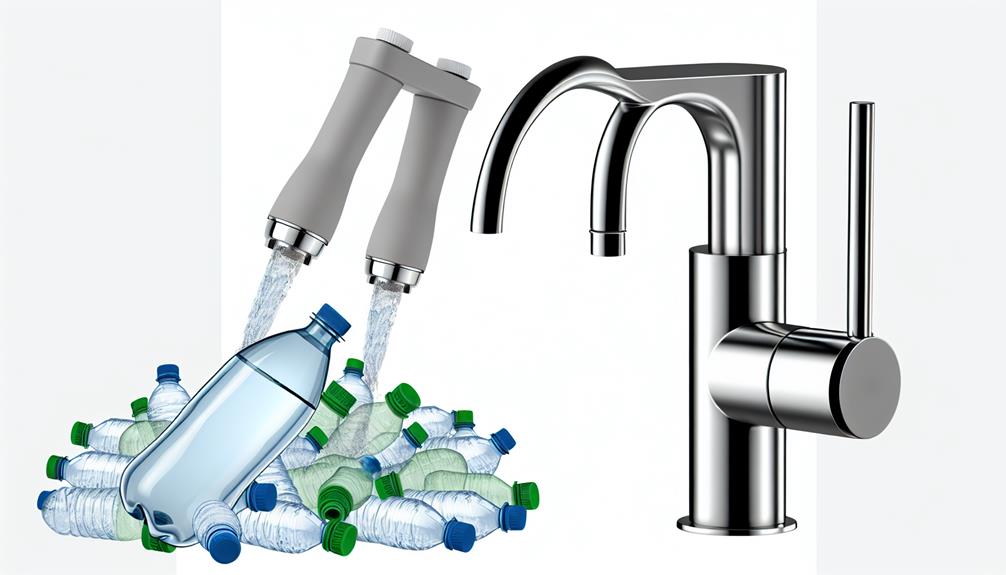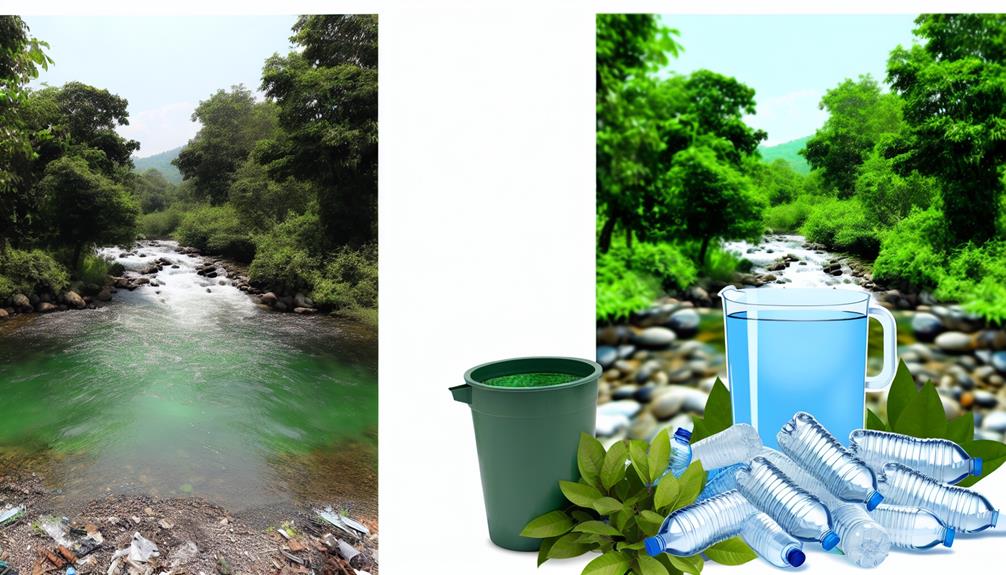Did you know that the production of a single water filter can generate approximately 2 kilograms of carbon dioxide? As you consider the environmental impact of your lifestyle choices, it's crucial to examine the carbon footprints associated with the items you use daily.
When you're sipping on that crisp, clean water filtered at home, have you ever stopped to think about the journey that water filter took before it reached your glass? From raw material sourcing to the manufacturing process, transportation, daily usage, and finally, disposal, each stage contributes to its overall carbon footprint.
You might find yourself questioning how different water filters—whether it's an APEC reverse osmosis system or a Brita pitcher—stack up against each other in terms of environmental impact. Stick around, and let's unravel the complexities behind these essential, yet often overlooked, household items.
Raw Material Sourcing Impact
When choosing raw materials for water filter production, it's essential to consider that the type of activated carbon used can significantly affect the overall carbon footprint. Activated Carbon Filters are integral to water filtration systems, and their carbon footprint associated with production varies based on the raw material.
For instance, while coal-based activated carbon might be readily available, coconut shell activated carbon is lauded for its smaller environmental impact. Life Cycle Assessment (LCA) studies have highlighted the importance of raw material sourcing impact.
The production process of activated carbon from coconut shells, for example, is more eco-friendly due to the use of renewable energy and the inherent benefits of using a waste product of the food industry. Moreover, coconut shell activated carbon is considered to have a more favorable carbon footprint when biogenic emissions are treated as neutral, reflecting the material's renewable nature.
Conversely, the environmental impact of other types, such as wood or peat-based activated carbon, can be higher due to direct emissions and the intensive electricity production required.
Your selection of raw materials has direct implications for the eco-friendliness of the water filter you're considering. Thus, it's crucial to weigh these factors to ensure a responsible production process.
Manufacturing Process Emissions
The production of water filters, particularly the manufacturing of activated carbon, is a significant source of greenhouse gas emissions, with coal-based filters having the most considerable impact. When you're considering the environmental impacts of your water filtration system, it's not just the end use you need to think about. The carbon footprints of these systems are shaped by the emissions that occur during their production and transportation.
For different types of water filters, manufacturing process emissions vary. The production of electricity needed for manufacturing and the direct emissions from the process itself are major contributors to a filter's overall carbon emissions. Notably, coal activated carbon filters show a higher impact in several environmental categories.
Reverse Osmosis Systems and other filtration system options also contribute to emissions, but it's the activated carbon filters, especially those derived from coal, that demand attention. They show the highest impact in ten out of twelve environmental categories, indicating a significant need for scrutiny and potential improvement.
As you weigh the options, remember that the carbon footprints of water filter production aren't just a matter of output, but a reflection of the energy and materials inputs. Understanding these manufacturing process emissions is crucial to making an informed choice about your water filtration system.
Transportation and Distribution Footprint
Understanding the transportation and distribution footprint is crucial as it accounts for a substantial portion of the environmental impact associated with delivering bottled water to consumers. The carbon footprint of bottled water production isn't just about the use of plastic; it extends to how the product reaches you. Water delivery, especially in single-use plastic bottles, involves a complex network of transportation that significantly contributes to carbon emissions.
Fuel consumption and emissions from delivery trucks are central to the transportation and distribution footprint. Every mile these trucks travel to bring bottled water to stores or homes adds to the carbon load on the environment. Moreover, the distribution networks required to manage and operate these deliveries further inflate the environmental cost.
By contrast, embracing bottle-free water coolers can mitigate these impacts. This environmentally friendly alternative can reduce the reliance on single-use plastic bottles, consequently decreasing plastic waste. It also slashes the need for regular water delivery, trimming down the transportation and distribution footprint considerably.
Assessing these footprints gives you a clearer picture of the environmental benefits of reducing the use of plastic in water consumption. It's not just about the product itself, but the journey it takes from production to your doorstep.
Usage and Energy Efficiency
While transportation and distribution significantly impact the environment, the usage of bottle-free water coolers introduces substantial energy efficiency benefits in office settings. By opting for a water filter system, you're not just ensuring access to cleaner drinking water; you're also engaging in a practice that's kinder to the planet.
To understand the energy efficiency gains, consider these facts:
- Companies using bottleless water coolers emit 53% fewer tons of CO2 per year for a 50-person office.
- This switch prevents the disposal of approximately 150 5-gallon plastic jugs or 6,000 single-use bottles annually.
- The annual cost savings can range from $2,700 to $3,600 for the same office size.
Home water filtration, including whole-house filtration and under-sink systems, such as reverse osmosis (RO), similarly offer eco-friendly solutions. These systems use advanced water treatment technologies, which, while requiring energy, often use less than the lifecycle energy costs associated with bottled water. Filters use layered processes to remove contaminants, ensuring that the water you drink is purified without the need for transportation and distribution of bottled water.
With various filtration options available, the choice to integrate an energy-efficient system into your daily routine isn't only environmentally responsible but also cost-effective.
End-of-Life Disposal Effects
Considering the environmental implications of water filter disposal is crucial, as improper methods can result in significant pollution and ecological harm. When you dispose of water filters improperly, you contribute to the growing problem of plastic waste. These filters, often constructed from non-biodegradable materials, can end up in landfills or, worse, in waterways, where they pose a threat to marine life and the overall health of our water supply.
Pitcher filters, commonly used in households, along with other filtration systems, often contain plastics and ion exchange resins. If not recycled, these materials can take centuries to decompose, releasing harmful substances into the environment. The Ecoinvent database, a comprehensive resource for life cycle assessment data, underscores the importance of considering the full life cycle of products to assess their environmental impact accurately.
To mitigate these effects, it's essential to recycle filters wherever possible. Recycling can significantly reduce the environmental footprint compared to the production and disposal of single-use plastic water bottles. Objective, data-driven approaches to end-of-life disposal are necessary to ensure that the benefits of using water filters aren't overshadowed by the consequences of their disposal.

